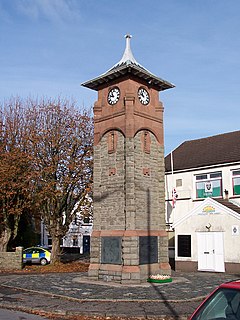Related Research Articles

Aberdare is a town in the Cynon Valley area of Rhondda Cynon Taf, Wales, at the confluence of the Rivers Dare (Dâr) and Cynon. Aberdare has a population of 39,550. Aberdare is 4 miles (6 km) south-west of Merthyr Tydfil, 20 miles (32 km) north-west of Cardiff and 22 miles (35 km) east-north-east of Swansea. During the 19th century it became a thriving industrial settlement, which was also notable for the vitality of its cultural life and as an important publishing centre.

Henry Austin Bruce, 1st Baron Aberdare was a British Liberal Party politician, who served in government most notably as Home Secretary (1868–1873) and as Lord President of the Council.

Hirwaun is a village and community at the north end of the Cynon Valley in the County Borough of Rhondda Cynon Taf, South Wales. It is 4 miles (6 km) NW of the town of Aberdare, and comes under the Aberdare post town. At the 2001 census, Hirwaun had a population of 4,851. increasing at the 2011 census to 4,990. The village is on the Heads of the Valleys Road and at the southern edge of the Brecon Beacons National Park.

Trecynon is a village near Aberdare situated in the Cynon Valley, in Rhondda Cynon Taf, Wales. It dates from the early nineteenth century and its developed as a result of the opening of the Aberdare Ironworks at Llwydcoed in 1800.

Llwydcoed is a small village and community north of the Cwm Cynon, near the town of Aberdare, Rhondda Cynon Taf, Wales, with a population of 1,302 as of 2011 census.

Richard Fothergill was an English ironmaster, a coalmine-owner in Wales and a Liberal politician who sat in the House of Commons from 1868 to 1880.
Thomas Price was a leading figure in the political and religious life of Victorian Wales and minister of Calfaria Baptist Chapel, Aberdare.
The Aberdare Urban District Council was established in 1894 and covered the parish of Aberdare. Its responsibilities included public health, sanitation, roads and public works generally.

Calfaria Baptist Chapel, Aberdare, was one of the largest baptist churches in the South Wales Valleys and the oldest in the Aberdare valley. The chapel had an ornate interior, including a boarded ceiling with a deeply undercut rose, while the balcony balustrading had a cast iron front with an intricate foliage design. These features were common in the Welsh chapels of the late nineteenth century. The organ was installed in 1903 at a cost of £850. It was played for the last time in 2012 by Robert Nicholls, during a Radio Cymru broadcast shortly before the closure of the chapel.
The first election to the Glamorgan County Council were held on 17 January 1889. Results were announced over several days. They were followed by the 1892 election. The authority, by far the largest county in Wales in terms of population, was established by the 1888 Local Government Act. The county of Glamorgan was at this time becoming heavily industrialised although some areas such as the Vale of Glamorgan remained essentially rural.
David Davis, Maesyffynnon, (1821–1884), son of David Davis, Blaengwawr was a prominent Welsh coal owner and public figure. He built upon the work of his father and expanded the family's industrial holdings in the Aberdare and Rhondda valleys. He had two daughters, Mary and Catherine. Mary married H.T. Edwards, vicar of Aberdare and later Dean of St Asaph and Catherine married Sir Francis Edwards.

Siloa, Aberdare was the largest of the Welsh Independent, or Congregationalist, chapels in Aberdare. Services are held in the Welsh language. Established in 1844, Siloa is one of the few Welsh language chapels in the locality to remain open today. Siloa was notable for its long-serving ministers and in over a century there were only three pastorates, namely those of David Price (1843–78), D. Silyn Evans (1880–1930) and R. Ifor Parry (1933–64).
The Aberdare Urban District Council was established in 1894 and covered the parish of Aberdare. Its responsibilities included public health, sanitation, roads and public works generally.
The Aberdare Urban District Council was established in 1894 and covered the parish of Aberdare. Its responsibilities included public health, sanitation, roads and public works generally.
The Aberdare Urban District Council was established in 1894 and covered the parish of Aberdare. Its responsibilities included public health, sanitation, roads and public works generally.
Owen Harris was a Liberal politician and municipal leader in Aberdare, South Wales.
The Aberdare Urban District Council was established in 1894 and covered the parish of Aberdare. Its responsibilities included public health, sanitation, roads and public works generally.
The Aberdare Urban District Council was established in 1894 and covered the parish of Aberdare. Its responsibilities included public health, sanitation, roads and public works generally.
Ebenezer, Trecynon is an Independent (Congregationalist) chapel in Ebenezer Street, Trecynon, Aberdare, Wales. It was one of the earliest Independent chapels in the Cynon Valley and remained an active place of worship until 2009.

St John the Baptist's is an ancient parish church in the centre of the town of Aberdare, Wales.
References
- ↑ Rammell 1853, pp. 28-9.
- ↑ Jones 1964, pp. 160–161.
- ↑ "Aberdare Board of Health". Cardiff and Merthyr Guardian. 22 September 1854. Retrieved 25 November 2013.
- ↑ "Aberdare. Meeting of the Board of Health". Monmouthshire Merlin. 21 July 1855. p. 5. Retrieved 13 July 2017.
- ↑ "Aberdare. Meeting of the Board of Health". Monmouthshire Merlin. 1 September 1855. p. 2. Retrieved 13 July 2017.
- ↑ "Board of Health Election". Aberdare Times. 1 September 1866. Retrieved 22 January 2014.
- ↑ "Aberdare. Board of Health Election". Merthyr Telegraph. 6 September 1856. p. 3. Retrieved 25 January 2016.
- ↑ "Aberdare. Board of Health Election". Merthyr Telegraph. 4 September 1858. p. 3. Retrieved 15 June 2017.
- ↑ "Local Intelligence". Aberdare Times. 15 August 1863. p. 4. Retrieved 11 August 2017.